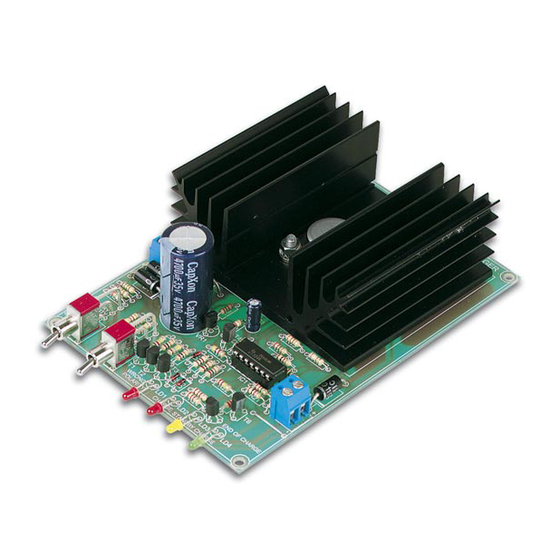Table of Contents
Advertisement
Quick Links
Download this manual
See also:
Manual
Advertisement
Table of Contents

Summary of Contents for Velleman K8012
- Page 1 Total solder points: 150 Difficulty level: beginner 1 advanced Intelligent lead acid battery charger K8012 ILLUSTRATED ASSEMBLY MANUAL H8012IP - 1...
- Page 2 Features & Specifications Features: Suitable for 6V and 12V sealed and open lead-acid batteries. Fully automatic charge and maintenance cycle. Status indicators for charge, float and end-of-charge Protected against polarity reversal Specifications: Power Supply: 2 x 9V/25VA Charge current : 0,3 or 1A selectable Dimensions (wxdxh): 97 x 140 x 41mm / 3,8 x 5,5 x 1,6"...
- Page 3 Assembly hints 1. Assembly (Skipping this can lead to troubles ! ) Ok, so we have your attention. These hints will help you to make this project successful. Read them carefully. 1.1 Make sure you have the right tools: • A good quality soldering iron (25-40W) with a small tip.
- Page 4 Assembly hints 1.3 Soldering Hints : 1- Mount the component against the PCB surface and carefully solder the leads 2- Make sure the solder joints are cone-shaped and shiny 3- Trim excess leads as close as possible to the solder joint REMOVE THEM FROM THE TAPE ONE AT A TIME ! AXIAL COMPONENTS ARE TAPED IN THE COR- RECT MOUNTING SEQUENCE !
- Page 5 Construction R13 : 10K (1 - 0 - 3 - B) 1. Jumper wires 3. Metal film resistors (1%) R14 : 10K (1 - 0 - 3 - B) R15 : 33K (3 - 3 - 3 - B) R16 : 10K (1 - 0 - 3 - B) R...
- Page 6 Construction 6. IC socket. Watch the 8. Transistors 11. Electrolytic capacitor. position of the notch! Watch the polarity ! T1 : BC547 T2 : BC547 C1 : 2µ2 C... T3 : BC547 T4 : BC547 T5 : BC547 T6 : BC557 9.
- Page 7 Construction 14. Power transistor 15. LEDs. Watch the polarity! T1 : MJ3001 LD1 : RED LD2 : RED COLOUR=2...5 LD3 : YELLOW LD4 : GREEN CATHODE CATHODE 16. IC . Check the position of the notch ! IC1: LM324 or eq.
- Page 8 Testing 17. Testing Perform all tests as shown below, before the first use of the unit. It allows you to check every function of your charger kit. Use the supplied 5W dummy load resistors and a reliable multimeter. -1- Put SW2 in the 12V position. Measure the voltage across the output terminals.
- Page 9 Testing -3- Put SW2 in the 12V position, put SW1 in the >4Ah position. Connect the supplied 33Ω/5Ω resistor to the output terminals. Measure the voltage across the resistor. It should read 14.7V +/- 0.1V Fig. 3.0 -4- Put SW2 in the 6V position, put SW1 in the >4Ah position. Connect the supplied 33Ω/5Ω...
- Page 10 Testing -5- Put SW2 in the 12V position, put SW1 in the >4Ah position. Connect the supplied 8.2Ω resistor in series with the multimeter. Switch the multimeter to the ‘10A DC’ - position. It should read 1A +/- 0.1A. Fig. 5.0 -6- Put SW2 in the 12V position, put SW1 in the <4Ah position.
- Page 11 Optional enclosure 18. Building into an optional enclosure Figure 7 & 8 provides a drill pattern for our optional enclosure (ref. TKAUS22G). The included adhesive front panel label can be used to mark the position of the holes to be drilled. Position the label on the front panel and fix it temporary with tape.
- Page 12 Optional enclosure Fig. 8.0...
- Page 13 Optional enclosure Figure 9.0. provides an internal view of the finished unit. Fig. 9.0 Make sure it is well ventilated, as the heatsink might run hot during charging...
- Page 14 Connection & Use 19. Connection & Use Connection: The unit can be connected as shown on figure 10. Fig. 10 Make sure your assembly complies with the local safety regulations. For improved safety, use a non-conductive enclosure.
- Page 15 Connection & use Use: perform the necessary settings before you hook-up the battery to the unit : Select the appropriate charge current and voltage according to the capacity of the battery. Batteries < 4Ah: 0.3A charge current Batteries > 4Ah: 1A charge current You can easily estimate the charging time with the following formula : Approx.
- Page 16 Operation & troubleshooting 20. Operation & troubleshooting Operation: When a discharged battery is connected to the unit, it starts charging it with the maximum current (0.3A for batteries <4Ah, 1A for batteries >4Ah), until the battery voltage reaches 14.7V (7.35V for a 6V battery). Once this voltage is established, the charger adjusts the charge current, in order to keep this voltage steady.
- Page 17 21. PCB...
- Page 18 Schematic diagram 22. Schematic diagram.
- Page 20 VELLEMAN Components NV Legen Heirweg 33 9890 Gavere Belgium Europe www.velleman.be www.velleman-kit.com Modifications and typographical errors reserved © Velleman Components nv. H8012IP - 2005 - ED1 5 4 1 0 3 2 9 2 9 0 7 1 9...














Need help?
Do you have a question about the K8012 and is the answer not in the manual?
Questions and answers